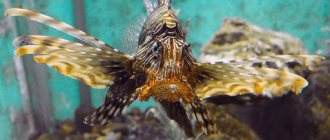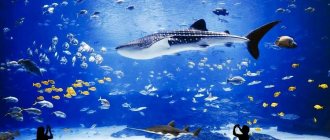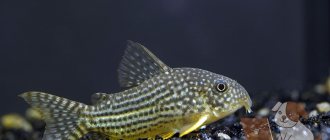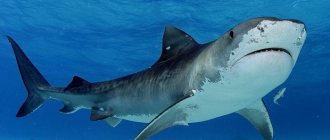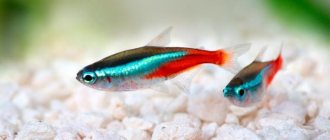Active human economic activity is increasingly becoming the cause of a decrease in the number of many animals, including fish. Uncontrolled commercial fishing, pollution of water bodies with harmful industrial waste and agricultural fertilizers, and the construction of hydraulic structures that limit free movement along rivers lead to a decrease in the rate of population recovery and the gradual disappearance of many valuable fish species.
In order to control and protect endangered animals, a list has been created, which includes species that are in danger of extinction. The document was called the Red Book. In addition to the unified international cadastre, lists of national significance have been developed. In Russia, adding a species to the Red Book automatically entails its protection at the legislative level. The list of fish listed in the Red Book includes more than 40 names.
Security categories
All species (taxa) included in the register are assigned a conservation status depending on the size and rate of population recovery. The following taxa require special attention:
- endangered (category No. 1);
- declining in numbers (category No. 2);
- rare fish of Russia (category No. 3).
Categories No. 4 and 5 include species without confirmation of rare status and those that have begun to recover, but still need protection.
Common sculpin
This fish is included in the second category of declining species. Its habitat is the European part of Russia and Western Siberia. The sculpin will not live in dirty water, and due to the high pollution of water bodies, its population is declining.
This is a small fish with a wide and flat head. During the daytime, it is inactive, most of the time it hides under stones and snags, which is why it got its name.
Rare fish of Russia from the Red Book
Let's take a closer look at the endangered fish species that live in our country.
Eisenam trout
Eisenam trout
The species is endemic, the range of which is limited to one reservoir - the mountain lake Eisenam, located in the North Caucasus. Eisenam trout is a residential species whose entire life cycle takes place in one body of water.
Until the middle of the last century, the population size was stable, but after the introduction of the chub in the 70s, the rate of renewal of the taxon slowed sharply. Recently, unauthorized fishing has led to a decrease in the number of trout.
TROUT
Abrau sprat
Abrau sprat
A freshwater species of sprat that is endemic. The taxon's habitat is limited to Lake Abrau, located in the Krasnodar Territory. Until the middle of the last century, sprat was one of the most numerous inhabitants of the reservoir, but after the artificial introduction of several species of predatory fish into the lake, its numbers began to decline sharply. An additional factor provoking a decrease in the population was a stable decrease in the water level in Abrau.
Nelma
Nelma
A species of the salmon family, which is sometimes considered a subspecies of the whitefish. Habitat: northern part of Russia. Nelma is a semi-anadromous fish that migrates from the White Sea and the Arctic Ocean to rivers. You can meet it in some lakes and reservoirs.
The number of nelma began to decline due to active fishing and the construction of dams and dams, which affected the water level in spawning rivers.
Sturgeon
Atlantic sturgeon
Sturgeon is one of the most valuable species of fish. The Red Book contains several varieties of sturgeon. Populations of Amur, Sakhalin and Siberian sturgeon include up to 2-2.5 thousand individuals and are under threat of extinction. But the Atlantic sturgeon is the rarest fish in Russia. Single representatives of the taxon occasionally enter water bodies included in the Baltic Sea basin, including Lake Ladoga.
The main factor that caused the critical decline in sturgeon numbers is intensive fishing. Even after the ban on sturgeon fishing was introduced, many sturgeon became targets for poaching. The decline in the rate of fish population renewal was due to pollution and the construction of hydraulic facilities on spawning rivers.
Siberian taimen
Siberian taimen
Freshwater fish, listed in the Red Book, inhabiting rivers and lakes of Siberia. In the Pechora and Kama basins the species is almost extinct. The main limiting factors include poaching, difficult passage along the riverbed to spawning grounds, and pollution of water bodies.
Sakhalin taimen
Sakhalin taimen
A small variety of taimen that lives in the Far East. The number of the taxon is declining due to uncontrolled fishing, including poaching. In addition, northern fish reach sexual maturity late and do not spawn annually, which also negatively affects the recovery of the species.
Sterlet
Sterlet
The fish is on the verge of extinction due to high consumer demand and uncontrolled fishing. Unfavorable factors that affected the abundance of the taxon also include shallowing of water bodies and deterioration of the ecological situation.
In the southern regions, sterlet is quite rare. Its larger populations live in Siberia. Limited fishing is allowed here in some water bodies. Attempts have been made to introduce sterlet to Pechora, but there is currently no data confirming successful adaptation.
STERLET
Grayling
Grayling
Until the 19th century, the taxon was widespread in water bodies of the north of the European part of Russia. Active uncontrolled fishing has led to a gradual decline in the population. In some reservoirs, complete extinction of the species was recorded.
Grayling prefers cool, clean water, so pollution of rivers and lakes with untreated sewage has had a certain negative impact on the reduction in its numbers. In water bodies where there are sufficient numbers of grayling, limited fishing is permitted under licenses.
Bersh
Bersh
A small predator that looks like perch and pike perch. It was widespread in the Volga, Terek, Ural and other rivers of the European part of Russia. Massive fishing with nets has led to a sharp reduction in the number of bersh.
Currently, strict restrictions have been introduced on catching the predator in order to restore its numbers.
Amudarya great shovelnose
Amudarya great shovelnose
A small freshwater sturgeon fish. Like many members of the family, the shovelnose is on the verge of extinction. The historical area was the Amu Darya and its tributaries. After the construction of hydraulic structures that blocked free movement along the riverbed, the area where fish lived was significantly reduced.
Pseudopathonos
Endangered species also include such species as the large and small Amu Darya pseudoshovel. The difference between these species is that they have a longer caudal peduncle, which is not completely covered with bony plates.
Kildin cod
Kildin cod
One of the endangered endemic species of the cod family. Kildin cod lives in Lake Mogilnoe located on the Kola Peninsula. The main condition for the normal existence of the species and its regular restoration was the special structure of the reservoir: layers of water with different mineral compositions did not mix. So, if in the uppermost layer the water was practically fresh (salinity no more than 3 ‰), then in the lowest it reached 30 ‰. This allowed both marine and freshwater organisms to develop within the same reservoir. Changes in the microclimate in the lake, as well as active fishing by the local population, have put the species at risk of extinction.
Common barbel
Common barbel
A large representative of the carp family. Natural habitat is deep, fast-flowing rivers. You could meet the barbel in the upper reaches of the Dnieper, large tributaries of the Desna and Nerussa. After the current was regulated, a tendency towards a gradual reduction in numbers appeared. Currently, the taxon has been assigned the status of a vulnerable species.
Small-scaled yellowfin
Small-scaled yellowfin
Fish of the carp family that lived in the Amur basin. Changing climatic conditions and uncontrolled fishing have led to its almost complete destruction.
Black Amur bream
Black Amur bream
Natural habitat - reservoirs belonging to the Amur basin. Fish spawning occurs mainly in China. The main factor that caused the decline in numbers to a critically low level is the intensive fishing of spawning individuals, as well as a decrease in water levels in reservoirs.
Black Cupid
Black Cupid
The species belongs to the carp family and is also known as Chinese roach. Found in large numbers in the Amur and Lake Khanka. In recent years, it has been classified as an endangered species due to intensive poaching both in China and Russia.
Muksun
Muksun
A large fish belonging to the salmon family. Historical range - rivers of the Primorsky Territory, bays of the Arctic Ocean with low salt content in the water. The decline in the population is caused by poaching during the spawning period and the active activity of gas production enterprises based in the habitats of the species.
Currently, there are strict restrictions on the catch of muksun. In recent years, artificial breeding of the species for commercial purposes has become widespread.
Podust
Podust
A schooling freshwater fish of the carp family. Lived in many large rivers of the European part of Russia. At the end of the 19th century, Podust was considered the most numerous inhabitant of the river. Moscow. Based on the results of control catches carried out at the end of the last century, the species was listed in the regional Red Book as very rare.
Lenok
Lenok
A representative of the salmon family, widespread in Siberia and the Far East, is on the verge of extinction. A decrease in the number of fish was recorded at the beginning of the last century and continues to this day. The main reasons for the population decline were human economic activities.
Carp
Carp
Belonging to the carp family, the carp and its subspecies kutum are semi-anadromous fish. Recently, it has practically not been found in traditional spawning areas, so it is not possible to accurately determine the number of taxa.
The main limiting factors include the construction of flow regulating facilities, a decrease in river levels as a result of irrigation of nearby farmland, and intensive fishing.
SALMON
Shemaya
Shemaya
A schooling fish from the carp family that inhabits the waters of the Black and Azov Seas. In the last decade, active efforts have been carried out to restore the species: more than 10 million fingerlings were released into natural habitats. An assessment of the situation with the species' abundance showed positive dynamics.
Outrigger
Outrigger
A medium-sized river fish from the salmon family. The species, previously widespread in Siberia, is endangered in its southern regions. The reduction in range is caused by poaching and changes in climatic conditions.
Common taimen
It lives in the eastern rivers of the Urals and Siberia, in Lake Baikal and Teletskoye. Also in the European part of Russia. These fish are classified as category 1 endangered species.
Taimen is a freshwater fish of impressive size. After all, it grows one meter long and weighs more than fifty kilograms. Polluted waters and mass poaching have practically destroyed these fish. In the above-mentioned habitats there are only single specimens.
Since 96 of the last century, taimen have been included in the Red Book, and from that time they began to actively work to save their individuals. Many artificial pools for breeding these fish have appeared. We also took under protection natural areas in which fish remained in small quantities.
Catch limits
All rare and endangered fish from the Red Book are prohibited from free catching in natural habitats. In some regions of Russia, in the presence of renewable endemic populations, recreational fishing is allowed under certificates that stipulate time and standards for catching. In order for fishing to bring only pleasure, you need to know what fish that are prohibited from catching are present in the reservoir, and also become familiar with the fishing rules in force in the region. Violation of regulations is subject to fines, administrative or criminal liability.
Black Cupid
A very rare fish, it belongs to the carp family. In Russia it can only be found in the waters of the Amur. Now there are so few of these fish that they are in the first category in the Red Book.
Black carps live just over ten years, and their sexually mature period begins only in the sixth year of life. Already adult individuals grow in size from half a meter in length and weigh 3-4 kg. They are classified as predators, so most of their diet consists of small fish and shellfish.
Dwarf roller
Most of their species live in the northern part of America. And only in the nineties of the last century, it was first seen in Russian waters. It lives in the Chukotka deep-water lakes.
This fish is small in size and at the age of seven weighs no more than two hundred grams. The number of these fish is unknown. In the Red Book it is included in the third category of special control.
Dorada
The weight of the carcass is 0.3-1 kg, the length does not exceed 40 cm. There are very few bones (those that are present are located along the ridge). Dorada has a rich taste - it is fried, stewed in sauce, baked, boiled, steamed, stuffed. The best seasonings are basil, rosemary, sage.
Important! The taste of sea bream deteriorates with prolonged heat treatment:
- steam it for no longer than 15 minutes;
- keep in the oven or over an open fire for about 10 minutes;
- in a frying pan - 2 minutes on each side.
To avoid deformation of the piece, the skin is pierced with a knife.
Sakhalin sturgeon
A very rare and almost extinct fish species. In the past, this fish was a long-lived giant. After all, over fifty years of life they grew up to two hundred kilograms. Nowadays, despite all the prohibitions, poachers do not stop their fishing, catching sturgeon en masse. In addition to their valuable meat, sturgeon caviar is priceless.
Nowadays, sturgeon no longer grow to enormous sizes. The maximum weight of an adult fish is no more than sixty kilograms, and they grow 1.5-2 meters in length.
The back and sides of the fish are covered with spines, protecting them from more predatory fish. And on its elongated muzzle there are whiskers, but not a pair, like catfish, but four. With their help, sturgeon probe the bottom surface.
Today, unfortunately, there are no more than 1000 of them. There is only one way to save these fish, and that is to raise them in specialized tanks. But this is only a small beginning. It is necessary to support their natural production and identify protected areas.
Since the sturgeon goes to the rivers to spawn, and subsequently the young grow up there in the first three to four years. It is necessary to clean them as much as possible from debris, logs, products of oil and other industries.
The question of which fish are listed in the Red Book remains open. From year to year, new names and descriptions of fish are added to it. And I want to believe that it will not only be those species that have disappeared forever that will disappear. But also fish, the population of which will be saved thanks to the measures taken to protect them.
Original recipes
You can prepare exotic fish dishes yourself - the idea that fish delicacies can only be tasted in a restaurant is wrong.
Boiled eel with lemon-egg sauce
The eel carcass (1.5 kg) is cut up - the head, tail, entrails are removed, and the skin is removed. The fillet is cut into pieces about 5 cm long. In a thick-walled roasting pan, the bottom of which is greased with 1 tsp. vegetable oil, add slices seasoned with salt and pepper, coarsely chopped herbs (you will need 1 bunch each of sorrel, parsley, chervil, sage, mint).
Simmer the eel over medium heat for 15 minutes, then add 150 ml of white wine, 50 ml of water. The mass is cooked for another 10 minutes, after which the pieces are placed in a deep bowl.
Beat 3 yolks with a whisk, adding lemon juice (you will need 2 large lemons), a pinch of salt, 1 tsp. honey Pour the sauce over the eel and leave at room temperature until completely cooled.
Sea rooster baked with cheese
2 onions are peeled, cut into half rings, and fried in vegetable oil. 700 g sea rooster fillet is cut into 5 cm pieces, seasoned with salt and pepper, and placed in a greased baking dish. 200 ml of cream mixed with paprika, dry dill (7 g each), 3 tbsp. grated cheese. The fish is sprinkled with lemon juice, covered with onions, and poured with a creamy mixture. The dish is baked at 180 degrees for 30 minutes.
Braised shark with pineapple
600 g of skinned herring shark fillet is poured with 120 ml of pineapple juice and left to marinate (30 minutes is enough). A small pineapple is cut into cubes, fried in melted butter (3 tbsp) until half cooked, poured with cream (150 ml/20%). Add 120 ml of fish broth, 2 tbsp. curry and simmer for 5 minutes.
The fillet is removed from the marinade and placed on a napkin. Corn starch (1 tsp) is diluted with juice and poured into boiling creamy sauce. The mixture is boiled until thick, seasoned with salt and pepper, after which the shark fillet is sent there. Simmer the dish under the lid for 10 minutes.
Grilled dorada
The whole carcass is cleaned, the entrails and gills are removed, washed, dried, and rubbed with salt. Place a sprig of rosemary and a lime ring cut in half inside. The peel is lubricated with vegetable oil. Dorado is fried on the grill on both sides for 7 minutes.
Steamed barramundi
Soy sauce is mixed with sweet chili sauce (0.5 tsp/1 tbsp). A square with sides of 50 cm is cut out of parchment. 2 lime leaves are placed in the center, and 300 g of barramundi are placed on top of them. The fillet is sprinkled with coriander (1 tbsp) and grated ginger (10 g), poured over with sauce. Gathering the corners of the square, a sealed “bag” is formed. The dish is steamed for 10 minutes, and when served, garnish with mint leaves and fresh cucumber slices.
The recipes are applicable to any type of exotic fish, the meat of which is suitable for the specified method of heat treatment.
Tilapia (tilapia)
Due to its unpretentiousness, tropical tilapia is widely cultivated in artificial reservoirs. It can be subjected to any type of heat treatment.
Important! Tilapia is high in protein but low in fat. To make the taste of the dish more rich, it is recommended to add wine or sauce. When baking, be sure to wrap the fillet in foil, otherwise it will become dry. Minced cutlets are enriched with softened butter.
sea lamprey
An inhabitant of the Caspian waters, however, it goes into rivers to spawn. Here is an interesting and sad fact from the life of lampreys. During spawning, males build nests and actively guard them while the female lays eggs. And after the end, they both die. The number of these fish is very small, and there are only a few of them on the territory of Russia.
This species of fish is exceptional in its appearance. They are earth-colored and have marbled spots all over their bodies. It is not clear what she looks like, either a snake or an eel. It grows a little more than a meter in length and weighs 2 kg.
The skin of the fish is smooth and not covered with scales at all. It came to us many centuries ago, and has not changed since then. In order to somehow help preserve their species, it is necessary to create artificial pools for their breeding.
Brown trout
Brown trout or also called river trout. Since this fish lives in shallow rivers and streams. Some of its species can also be found in the Baltic Sea.
The number of these fish began to decrease because they were caught uncontrollably. Currently, in the Russian Federation, there are entire protected areas for their breeding.
European grayling
These fish prefer to live in clean, cold waters of rivers, lakes and streams. It is named so because most of it lives in European territories. Nowadays, the brook grayling is most adapted to life.
They differ from lake and river fish in that they go to spawn at an earlier age and are smaller in weight and size. Its numbers declined catastrophically in the century before last.
Pagr
The red pagr lives only in the Pacific Ocean (in its northwestern part). The maximum body length is 120 cm. It tastes like sea bream, but the meat is more tender, less fatty and has an interesting pink color. Any type of heat treatment is acceptable - pagra is boiled, baked under a vegetable bed, steamed, fried in batter or breading.

